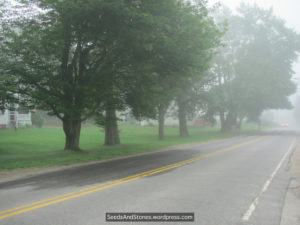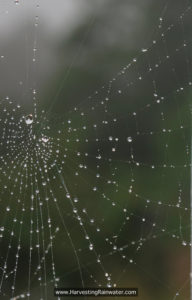Fog Harvesting with Living Systems
by Brad Lancaster © 2014
www.HarvestingRainwater.com
Got fog? Plant and grow living fog-harvesters or become one yourself, and you’ll end up increasing your rainfall—or at least your fogfall.

Many native plants that grow in areas where fog is a regular occurrence have adapted their leaf structure to harvest fog. The fog gathers/precipitates on the rough/fine surface area of the leaves then drips/rains down to the soil as “fog precipitation.” The coastal redwood tree (Sequoia sempervirens) is an excellent example of the impact of this phenomenon; one study in northern California found that on average 34% of the annual hydrologic input was fog-drip off the redwood trees themselves, while in areas without the redwood trees, fog accounted for only 17% of the water input. These data demonstrate that the trees significantly influence the volume of fog-water entering the system.1 The study also found that in summer when fog was most frequent, and rainfall was absent, about 19% of the water within the redwoods—and about 66% of the water within the understory plants—came from fog after it had dripped from the leaves of the trees.2
Fog-drip from trees can be, and has been, harvested in cisterns to provide drinking water, as was the traditional practice with the “rain tree” (Ocotea foetens)3 of Hierro, otherwise known as the “holy tree,” or “garoe,” which grows in laurel-forest habitat at elevations between 400 and 1400 meters in Madeira, Azores, and the Canary Islands.4
Rain tree image links:
- The Canary Islands; & a Draught of the Fountain-Tree in the Island of Ferro.
Designed & Engraved for the Universal Magazine for J.Hinton, at the Kings Arms in St Pauls Church-Yard, London, 1748. - A contemporary photo of Water Fountain (tree) on Garajonay—scroll down linked page to see photo.
Rather than building a roof from which you can capture water, in the right fog-rich areas it is wiser to find or plant a tree—that’s a living system.
Coastal ridgeline forests—where fog gathers—are ideal for collecting fog, and the fog harvested by the vegetation typically contributes significant volumes of water to groundwater, springs, and creeks. So when these forests are removed, the inputs to groundwater, springs, and creeks are reduced—sometimes to the point that the spring and creek flows cease as groundwater levels drop.
Manufactured fog-catching sails (which mimic fog-harvesting spider webs) with gutters below are a non-living means of harvesting fog, though they can be used to capture water to irrigate and reestablish native living fog-harvesting trees. That’s the case in Bellavista, Peru, where over 800 river she-oaks have been planted and irrigated during the establishment period with fog harvested from a human-made fog-harvesting sail.5

The YouTube video From Thin Air features the FogQuest effort to provide drinking water from fog with manufactured fog-collecting screen sails and gutters below.
Efforts are underway to improve the efficiency of such fog sails by basing their design on the skin of fog-harvesting Namibian beetles (Stenocara gracilipes).6
There are a number of different fog-harvesting beetles in the dry, yet fog-rich, coastal area of Namibia. All the beetles climb to the top of coastal sand dunes, where some of these beetles harvest fog off their backs, while others build or dig fog-harvesting sand ridges or trenches on the dunes.7
We can mimic such adaptive behavior, either by planting or supporting fog-harvesting vegetation, adapting materials used in constructed fog-harvesting screens, or learning from the behaviors of fog-harvesting beetles and other life forms, including those that we have not yet discovered. The living natural world has more to teach us than we could ever imagine.
_ _ _ _ _ _ _ _ _ _ _ _ _ _ _ _ _ _
REFERENCES:
1. “Fog in the California Redwood Forest: Ecosystem Inputs and Use by Plants,” by T.E. Dawson, Oceologia, 1998. http://link.springer.com/article/10.1007%2Fs004420050683#page-2, accessed 7-21-2014.
2. “Fog in the California Redwood Forest: Ecosystem Inputs and Use by Plants,” by T.E. Dawson, Oceologia, 1998. http://link.springer.com/article/10.1007%2Fs004420050683#page-2, accessed 7-21-2014.
3. The Laurel or Bay Forests of the Canary Islands, C.A. Schroeder, Department of Biology, University of California, Los Angeles. California Avocado Society 1989 Yearbook 73:145-147. http://www.avocadosource.com/CAS_Yearbooks/CAS_73_1989/CAS_1989_145.htm, accessed 7-21-2014.
4. Ocotea foetens, Wikipedia, http://en.wikipedia.org/wiki/Ocotea_foetens, accessed 7-21-2014
5. “Fog Catchers Bring Water to Parched Villages,” National Geographic, http://news.nationalgeographic.com/news/2009/07/090709-fog-catchers-peru-water-missions/, accessed 7-21-14. Photos can also be found at http://poleshift.ning.com/profiles/blogs/photos-fog-catchers-harvest.
6. “Water Vapor Harvesting: Namib Desert Beetle,” http://www.asknature.org/strategy/dc2127c6d0008a6c7748e4e4474e7aa1#.U84AdaiySkc, accessed 7-21-2014.
7. “Fog-Basking Behaviour and Water Collection Efficiency in Namib Desert Darkling Beetles,” Thomas Nørgaard and Marie Dacke, Frontiers in Zoology 2010, 7:23, http://www.frontiersinzoology.com/content/7/1/23, accessed 7-21-2014.
ADDITIONAL FOG-HARVESTING RESOURCES:
“The Role of Wind in Rainwater Catchment and Fog Collection“
by Robert S. Schemenauer and Pilar Cereceda, Water International (1994)
Vol 19, pp 70-76
(Thank you to Tim Cass for sending us this article)
Fog Harvesting in Morocco with Dar Si Hmad
Includes articles and video presentations
darsihmad.org/index.php/en/programs-en/fog-harvesting-en
“The Rain Tree of Hierro, Canary Islands. (Oreodaphne foetens)”
J. Hutchinson, Bulletin of Miscellaneous Information (Royal Botanic Gardens, Kew)
Vol. 1919, No. 3 (1919), pp 153-164
Published by: Royal Botanic Gardens, Kew
Fog-Harvesting cactus (Opuntia microdasys)
wattsupwiththat.com/2013/02/21/harvesting-fog-the-no-regrets-option/
Accessed July 22, 2014
Fog Harvesting
www.oas.org/dsd/publications/unit/oea59e/ch12.htm
RELATED RESOURCES:
Dew Harvesting with air well (condenser) en.wikipedia.org/wiki/Air_well_%28condenser%29
Deflection of drying wind from grapes in Canary Islands with pits and stone walls
www.bowlerwine.com/site/producers/400.html
www.beendoonsolong.com/2010/11/on-a-mission-the-germ-of-an-idea/
See the new, full-color, revised editions of Brad’s award-winning books
– available a deep discount, direct from Brad:

Volume 1

